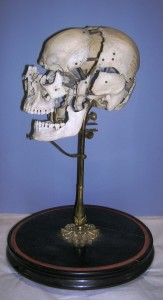Warren Museum medical case featured in Journal of Bone and Joint Surgery

Still of Charles Lowell CT scan, 2009, WAM 07877, Warren Anatomical Museum, Francis A. Countway Library of Medicine
In the September 5th edition of The Journal of Bone & Joint Surgery, William H. and Johanna A. Harris Professor of Orthopedic Surgery James H. Herndon, M.D. published an orthopedic and historical analysis of one of the Warren Museum’s most compelling medical cases, the sacrum, pelvis and femur upper extremities of an early 19th century Maine resident named Charles Lowell. Lowell is recognized as MGH’s first orthopedic case and his accident and subsequent malpractice claims are cited as one of earliest, well-published medical trials in the Unites States.
On September 7, 1821 Lowell was thrown from his horse in Lubec, Maine, dislocating his left hip. His two physicians, John Faxon and Micajah Hawkes, believed they successful reduced the hip but when Hawkes visited Lowell 4-6 weeks later, he found that the injury persisted. Lowell traveled to the newly found Massachusetts General Hospital and its chief surgeon [and Warren Museum founder] John Collins Warren for relief. After much effort, Warren was unable to reduce the injury. Lowell left Boston vowing to sue Faxon and Hawkes for failing to repair his hip.
Lowell vs. Faxon and Hawkes went through three trials. In June 1822 a jury found for Lowell. An appeal in September ended in a hung jury. The final trial in 1824 was the most involved, with many physicians, including John Collins Warren testifying. Warren later published his remarks in an explanatory pamphlet. The case ended in the physicians’ favor. As the specifics of his injury proved the crux of the trial, Lowell was determined to have a postmortem done and upon his 1858 death Jonathan Mason Warren [John Collins Warren’s son] sent a colleague to perform the autopsy, bringing the hip back to Boston with family consent for further examination. This was the last orthopedic analysis done of Lowell’s injury – until Herndon’s 2010 study.
Lowell’s hip preparation was transferred to the Warren Museum by J. Collins Warren [John Collins Warren’s grandson] and accessioned into the collection circa 1885. In 2010 James Herndon, with

Historical photograph of Lowell hip preparation, 1858-1915, WAM 07877, Warren Anatomical Museum, Francis A. Countway Library of Medicine
permission from the Museum, took radiographs and a CT scan of Lowell’s hip. His findings, entitled An Orthopaedic Case Contributed Substantially to the First Malpractice Crisis in the United States in the Nineteenth Century, have been published in Volume 94-A, Number 17 of the Journal of Bone and Joint Surgery. Dr. Herndon generously donated copies of the scans and radiographs to the Warren Museum to benefit future researchers.
The Charles Lowell pelvis and femur preparation can be found exhibited in the Warren Museum Exhibition Gallery on the 5th floor of the Countway Library of Medicine on the Harvard Medical School campus. More information on visiting the Gallery can be found here.

 Since its transfer into the Center for the History of Medicine, the Warren Museum has been photographing its historic collection. One recent image is this beauchene or ‘exploded’ skull . The skull was prepared by and purchased from the Parisian anatomists Vasseur and Tramond in the 19th-century. “Mon Vasseur, Tramond S, A Paris 9. lup de L’ ecole de medecine” is inscribed in ink on the skull’s left parietal bone.
Since its transfer into the Center for the History of Medicine, the Warren Museum has been photographing its historic collection. One recent image is this beauchene or ‘exploded’ skull . The skull was prepared by and purchased from the Parisian anatomists Vasseur and Tramond in the 19th-century. “Mon Vasseur, Tramond S, A Paris 9. lup de L’ ecole de medecine” is inscribed in ink on the skull’s left parietal bone.